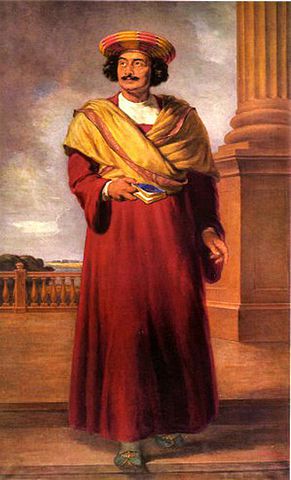At the time when the British made India as one of their colonies, there were many practices that were rampant in the country on the social front. However, one social practice that made a deep impact even on the British officers was the Sati system. Sati in Sanskrit translates to mean ‘virtuous woman’.

History of Sati
The evidence of practice of Sati in India can be traced to around 10th century AD. Sati or Suttee (as the British pronounced it) during those days was an evil practice (not considered to be evil then) that had been passed down from generations to generations. A recently widowed woman was called Sati when she, in order to be with her dead husband, sat on or jumped into his funeral pyre.
One of the reasons this act of Sati became a custom was that during those times, it was believed to be part of the Hindu religion. Anything that relates to religion was considered to be a good and pious. Another attribute for this could have been the status of the women in the society. It had been a strong belief in the society for a long time that women did not have any independent existence of their own in the absence of their husband.
Women were regarded to be inferior to men in the social strata. Some have also reasoned the practice of Sati as a saving grace for the widowed women who otherwise would have been exposed to uncertain future that could involve starvation, exploitation, etc. The concept of Sati was earlier only prevalent amongst the higher caste people. However, over the period of time, it became a common practice even amongst the lower caste.
Status of Women in British Indian Society
It had been a strong belief in the society for a long time that women did not have any independent existence of their own in the absence of their husband. Women were regarded to be inferior to men in the social strata. Some have also reasoned the practice of Sati as a saving grace for the widowed women who otherwise would have been exposed to uncertain future that could involve starvation, exploitation, etc. The concept of Sati was earlier only prevalent amongst the higher caste people. However, over the period of time, it became a common practice even amongst the lower caste.
The system of Sati is said to have originated from a mythological story. As per the legend, Sati was Lord Shiva’s wife. However, her father, King Daksha did not approve of Lord Shiva as his son-in-law. Once, King Daksha had organized an event at his house. Sati went alone to this event as her husband did not join her.
There she is believed to have immolated herself as a mark of protest against the kind of insult and humiliation that her husband was subjected to. Although it could be regarded as an idea for the Sati system, the mythological story and real act of Sati were poles apart.
One major difference between this mythology and Sati system prevalent in India was that in the story, though the wife immolated herself in order to preserve her husband’s honour, he being immortal could not have died. However, in India, Sati was practiced only after the death of the husband. Women were expected to honour and show respect towards the deceased husband by practically committing suicide.
The notion of Sati was also triggered by those who saw their personal gains on the death of a widowed woman like taking her jewelry, property, etc. In cases where the woman resisted, she was forcibly thrown into the fire. Music was played by local men near the pyre as soon as the ceremony was to commence.
This was done so that the painful screaming of the burning woman could not be heard. During those times, women were married off at a very young age and were mentally trained to do anything for upholding the dignity of their husband. The women were also mentally prepared to commit Sati as this was something they knew happened to widowed women. The entire idea of Sati revolved around the concept that a woman by committing Sati would be fulfilling her duty as a wife and that she would be regarded highly in the eyes of the society.
Policy of foreign powers towards Sati
When Sati was in vogue, foreign powers had begun trading with India. After a time, these powers like Portuguese, French, and the Dutch had even started colonization of Indian territories. Sati was officially banned in the 16th century by the Portuguese in Goa. Goa was the only Portuguese colony in India. Other foreign powers like the French and the Dutch, which were controlling some territories in India also prohibited the practice of Sati in those territories. Prior to the British, efforts to curb this rampant social evil were made by Mughal King Akhbar, Jahangir, Ahilyabai Holkar, Peshwas, etc.
Other foreign powers like the French and the Dutch, which were controlling some territories in India also prohibited the practice of Sati in those territories. Prior to the British, efforts to curb this rampant social evil were made by Mughal King Akhbar, Jahangir, Ahilyabai Holkar, Peshwas, etc.

Sati and British Policy
Governor General Lord Bentinck was the only official who had thought of taking some concrete steps against this inhuman tradition. The Governor Generals before Lord Bentinck hardly did anything to dissuade people from continuing Sati. British strongly felt that non-interference in the Indian customs was a better approach to run the country. They felt meddling in the religious beliefs of the people could result in chaos and revolt. Thus the British preferred to allow the Sati system, although even to them it was an inhuman practice.
Steps taken against Sati
The major step taken by the British towards curbing this evil practice was in 1798. The maximum instances of Sati were reported from the Presidential town of Calcutta. However, the policies to curtail the Sati system were brought into effect in all the three Presidential towns namely, Bombay, Madras and Calcutta.
Although these measures were brought into effect, this did not immediately translate into anything substantial in respect of bringing this evil tradition to a stop. Although a law had been passed to put an end to the social evil of Sati, it took some time for the effect to bear the fruits since the concept of Sati was revolved around mythology. Also, the practice of Sati it had been deeply rooted in the minds of the locals, who refused to divert from the tradition.

One of the major pioneers against this age old practice was Raja RamMohan Roy. Since the very beginning, he was against this system. He had himself witnessed Sati very closely when his sister-in-law was forced to give up her life and jump into the funeral pyre of her husband. He even went to the extent of travelling to England to put forth his views on Sati.
He presented his case before a panel appointed by the Government. Ram Mohan Roy was subjected to criticism and ridicule from his own countrymen for opposing Sati system. However, this did not deter his spirit and he continued to work for the betterment of women. Even Christian missionaries who came to India tried to persuade people to discourage this inhuman practice. One such missionary was Willaim Carey. He was a Baptist minister and social reformer in Britain.

The British introduced an Act in the 1829. This Act was known as the Bengal State Prohibition Act of 1829 or Bengal Sati Regulation, 1829. Prior to the passing of the Act, Lord Bentinck had done a detailed study on the issue. He is said to have even spoken to his Indian officers under his command and weighted the impact it may have amongst the people and for the Britishers. The enforcement of this Act proved to be the final nail in the coffin of the inhuman practice of Sati. The person responsible for bringing the said Act into effect was Lord William Bentinck. Even today, he is remembered for his good work.